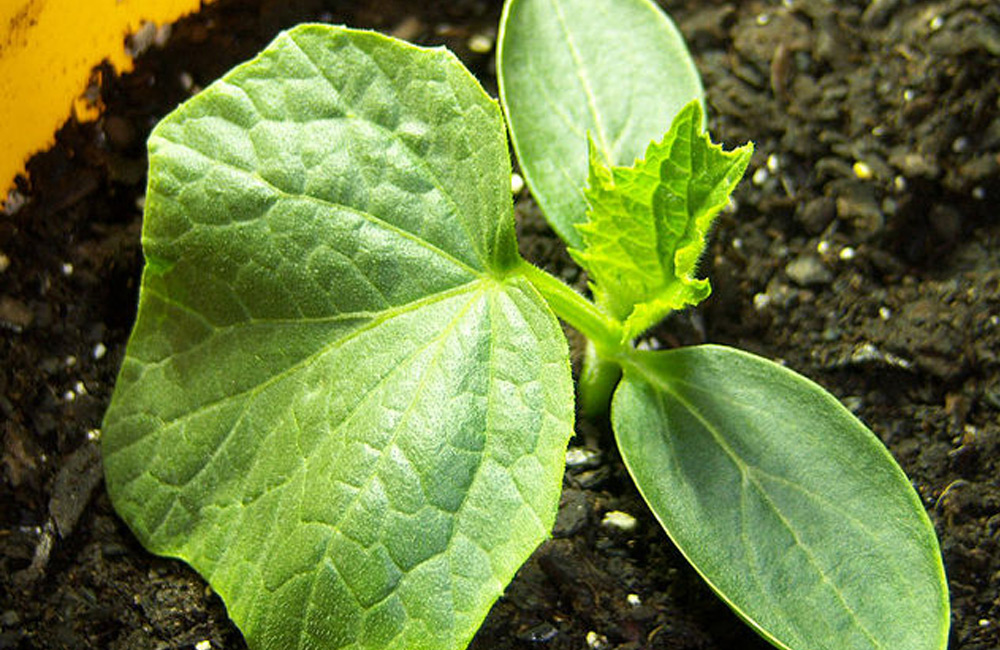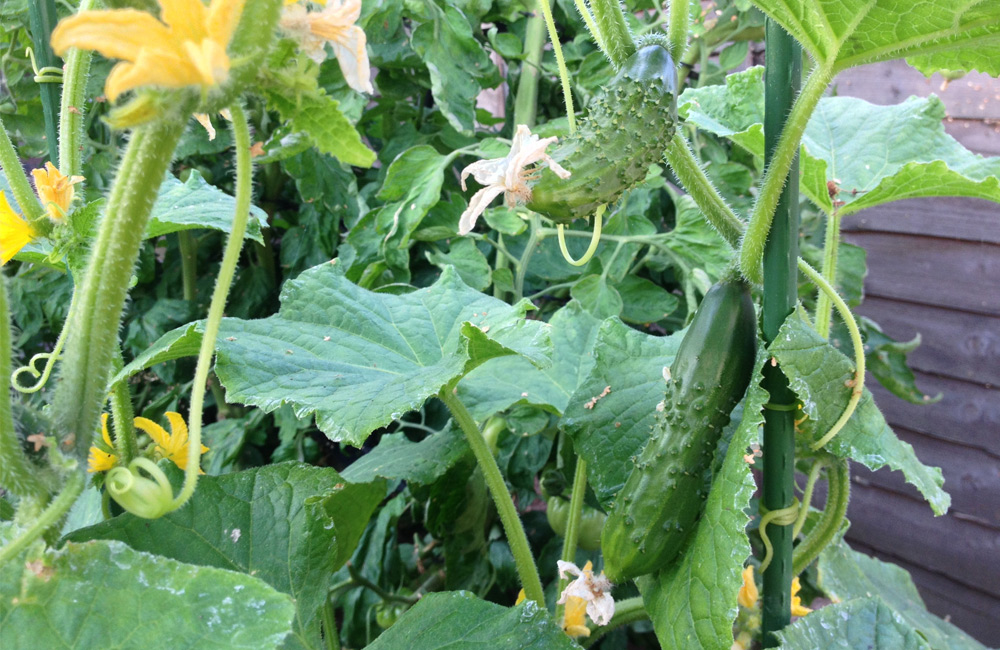How to Grow Cucumbers

If you are interested in growing healthy and delicious cucumbers you will need to understand the main differences between the two varieties. There are greenhouse cucumbers, as well as outdoor varieties. It is not difficult to grow cucumbers, but each type of cucumber will require its own unique care in order to grow successfully.
Even if you have a small space it is possible and even easy to grow yummy cucumbers. Keep reading to learn how to grow both varieties of cucumbers.
The Two Main Types of Cucumbers
Greenhouse and outdoor are the two main varieties of cucumber. If you are planting greenhouse cucumbers, you will get the type of cucumber you find in your local grocery store. Greenhouse cucumbers have a long, cylindrical shape and smooth, bright green skin. The greenhouse variety of cucumber should not be pollinated as it causes a less pleasing taste. In order to avoid this bitter taste in your cucumber either remove any male flowers or purchase an all-female F1 hybrid variety of cucumber such as the cucumber bella.
Outdoor varieties are also known as ridge cucumbers because of their bumpy skin. These cucumbers are shorter and plumper than the greenhouse cucumber. If you are growing an outdoor variety of cucumber, they will need pollination. Generally, you can leave this up to nature, as insects do the job nicely.
Can I grow cucumber from seed?

Yes you can grow cucumber from seed, but it's important to understand the time of year.
The time of year you plant your cucumber seeds will be dependent on whether you have a heated greenhouse, an unheated greenhouse, or if you are planting outside. You can plant as early as February if your greenhouse is heated. Wait until May if you are planting your seeds outside. If you have an unheated propagator in which to plant, it shouldn’t be a problem to plant in mid-March or early April.
When you plant your cucumber seeds, you will want to use 7.5cm free draining pots. The seeds should be planted at a depth of 1cm. After planting the seeds, they should be kept at a temperature of 20 degrees Celsius for 7 - 10 days. You can do this by placing your pots in a propagator or inside a plastic bag.
After your cucumber seeds have germinated, simply move them to a bright, sunny windowsill where they can stay warm until they are big enough to be transplanted. Try not to let your plants get too cold, they should be kept at a minimum temperature of 15°C. Pay attention to how much water your cucumber plants are getting, the compost should be moist, but not completely saturated. Water small amounts, but water fairly often. Cucumber seedlings can get scorched by direct sunlight so keep an eye on them if the sunlight is strong and direct. Those tiny plants are fragile, once they are big enough to transplant, it is important to be gentle with the roots.
Growing Cucumbers in a Greenhouse
When to plant: If your greenhouse is not heated, it is wisest to hold off planting your tiny cucumber plants until late May. If you have a heated greenhouse you can safely plant in late February or March.
Spacing: Greenhouse cucumber plants need to be about 45cm apart. If you are using a grow bag, plant only two per bag.
Care: Regularly spraying water inside your greenhouse, especially on your pathways will help to keep the humidity levels in your greenhouse high. If you are worried about your plants getting scorched by the sun, use screens on the hottest days. Use a liquid fertiliser on your plants every two weeks to provide nutrients.
Trailing Cucumbers: Encouraging more side shoots on a cucumber plant will produce a bigger yield. You can do this by providing your plants with a vertical stake to climb. Start by setting up a wire, stretched from one end of your greenhouse to the other to support the vertical canes. Push a cane in beside each cucumber plant, and simply tie in the cucumbers as they grow, this will train the main shoots to climb. Once the plant climbs to the top of the support, use your thumb and forefinger to pinch out at the growing point. Later, as you notice fruit beginning to develop, pinch out the end of each side shoot. Allow only two leaves after each fruit, this will encourage more and more side shoots.
Remove Male Fowers: Male flowers have a plain, thinner stalk, unlike the female flower which has an immature cucumber between the flower and the stem. Always remove the male flowers to prevent pollination resulting in a bitter tasting cucumber.
Need a new greenhouse? Browse our range at South West Greenhouses here.
Growing Cucumbers Outdoors

When to plant: Outdoor cucumbers (ridge cucumbers) should not be planted directly into the soil in colder conditions, instead slowly acclimate your cucumber plants over 7 - 10 days. You can do this by leaving them outside for only 3-4 hours to start and bringing them in at night. Gradually increase the length of time you leave them outside over the 7 - 10 days.
Location: If possible, cucumber plants should be sheltered from the wind and placed in a sunny area.
Spacing: Unlike greenhouse cucumbers, you will not need to encourage your outdoor cucumbers to climb. Allow them to sprawl across the ground but give them plenty of space. Outdoor cucumbers will need to be planted about 90cm apart.
Care: Keep a close eye on your outdoor cucumbers and pinch them out at the top when seven leaves are present. This will help to yield a bigger crop.
Keep Male Flowers: Greenhouse cucumbers should not be pollinated but outdoor cucumbers should. It is important to allow insects to pollinate your outdoor cucumbers, so just leave both the male and female flowers alone.
Which Varieties of Cucumbers Can Be Grown Indoors and Outdoors?
There are definitely some varieties of cucumbers that can be grown either in a greenhouse or outside. A couple of examples include the all-female ‘Swing’ F1 Hybrid (a longer cucumber), or The ‘Diva’ (a seedless mini cucumber).
Being aware of the type of cucumbers you are growing in the same space is important. Planting outdoor cucumbers alongside an all-female variety can cause cross-pollination which will lead to a bitter tasting cucumber.
Harvesting Cucumbers
It typically takes a cucumber twelve weeks to grow big enough to harvest. This twelve-week guideline can change slightly with different varieties. Keep a close eye on your cucumbers and harvest when they are still young. Older fruit will not taste as sweet, once your fruit shows signs of producing seeds it may become bitter tasting.
Avoid the hot afternoon sun when harvesting your cucumbers. Early morning is the best time to harvest. Use a sharp knife or hand pruners to snip the fruit off of the plant.
You will get a longer season if you harvest your cucumbers often. Outdoor varieties may continue to produce fruit right up until September and greenhouse types can continue production into October.
Common Problems
Check your plants often for a yellow mosaic pattern. This distinctive pattern indicates that your plants have been infected with cucumber mosaic virus (a virus spread easily by aphids). This disease will quickly spread to your other plants if you do not immediately destroy the infected plants.
If you notice white patches and small shrivelled leaves on your plants it may indicate the presence of powdery mildew. Powdery mildew will render your crops inedible. You may be able to avoid powdery mildew by sufficiently watering your plants.
Whitefly are small white insects that are disastrous to plants. They will cause the growth of black mould and your plants will become unhealthy. You can fight whitefly with yellow sticky traps, and regularly spraying the underside of the leaves with a soap-based spray.
Red spider mite will cover your plants in a fine webbing and can even kill your greenhouse cucumbers. To fight the Red spider mite, burn any leaves that look reddish and rusty, or use a biological control.
Click on the following links to discover how to protect your cucumber plants against slugs and snails.
 Author:
Author: